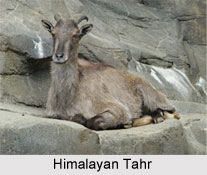 Himalayan Tahr is a big mammal with hoofs, having resemblance with a wild goat. In the wooded hills and mountainous slopes of the Himalayas, one can easily come across a Himalayan Tahr. During summer season, multitudes of Himalayan Tahr are found grazing in high pasture lands. However in the cold winter season, they descend to the mountains, forming `mixed-sex herds`.
Himalayan Tahr is a big mammal with hoofs, having resemblance with a wild goat. In the wooded hills and mountainous slopes of the Himalayas, one can easily come across a Himalayan Tahr. During summer season, multitudes of Himalayan Tahr are found grazing in high pasture lands. However in the cold winter season, they descend to the mountains, forming `mixed-sex herds`.
After conducting numerous surveys in the region, the eminent zoologists have brought about certain important facts about the Himalayan Tahr. According to them, it is one of the three species of Tahr, the other two being the Nilgiri Tahr of south India and the Arabian Tahr of Oman. However, only recently, it has been found out that all the three groups of Tahr belong to three individual groups.
Physical Features of Himalayan Tahr
The physical beauty of the Himalayan Tahr too draws attention to all the tourists. A Himalayan Tahr has got comparatively short legs and tiny heads with huge eyes and also little piercing ears. Hooves are the specialty of the Himalayan Tahr. The hooves have elastic, chewy core that permits them to grasp smooth rocks, while a stiff, pointed `rim` can `lodge` into minute footings. There are certain identifiable features of male species of this Himalayan Tahr. For example, they are lager in size. Also, their body complexion as well as the formation of horns is quite distinct from that of the females. The weight of a fully grown Himalayan Tahr varies from 135 to 180 kg or 300 to 400 lb. Their length is from 120 to 170 cm and also 60 to 90 cm tall.
Life Span and Training of Himalayan Tahr
 Certain other information about the Himalayan Tahr like life span, training of the young etc too can be known. Seven months are the gestation period of the Himalayan Tahr, and by and large only one child is born at a time. In the lapse of wild forests, it is assumed that a Himalayan Tahr can live up to fifteen years. Even a Himalayan Tahr can even expand its life to 10 years.
Certain other information about the Himalayan Tahr like life span, training of the young etc too can be known. Seven months are the gestation period of the Himalayan Tahr, and by and large only one child is born at a time. In the lapse of wild forests, it is assumed that a Himalayan Tahr can live up to fifteen years. Even a Himalayan Tahr can even expand its life to 10 years.
Even in the writings of the famous conservationist Jim Corbett, mention has been made of a Himalayan Tahr. He was mesmerized to see the way how a female Himalayan Tahr tolerantly teaching her child to jump from a steep rock cliff. This cliff is about 20 feet high and at its bottom there is a narrow bulge almost few inches in width. Interestingly, after leaving the young Himalayan Tahr, the mother climbs down the cliff and then waits for the child to follow her. Since the child Himalayan Tahr could not gather enough courage, the mother returns to another pathway and tries the steps again and again. So much so that the mother Himalayan Tahr continues the steps several times, till her child finally could perform the task.
Diet of Himalayan Tahr
Being an herbivore, a Himalayan Tahr survives on things like grass, shrubs, trees and some fruits. It consumes more woody plants than herb species.
It was the observation of some of the experts that due to several hunting expeditions, there is a possibility of the Himalayan Tahr to go into extinction. Even the World Conservation Union (IUCN) regards the Himalayan Tahr of the Himalaya to be quite susceptible to several threats of modern day life.











